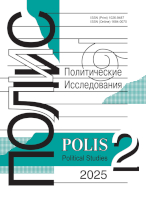Media models of propaganda:
the COVID-19 pandemic in Russian-language media with a “different opinion”
Radina N.K.,
Lobachevsky State University of Nizhny Novgorod, Nizhny Novgorod, Russia; HSE University, Nizhny Novgorod, Russia, rasv@yandex.ru
elibrary_id: 417954 | ORCID: 0000-0001-8336-1044 | RESEARCHER_ID: L-6641-2015
Article received: 2022.05.02. Accepted: 2022.11.16

DOI: 10.17976/jpps/2023.04.10
EDN: SBFJII
Radina N.K. Media models of propaganda: the COVID-19 pandemic in Russian-language media with a “different opinion”. – Polis. Political Studies. 2023. No. 4. https://doi.org/10.17976/jpps/2023.04.10. EDN: SBFJII
The study was supported by the Russian Science Foundation grant No. 22-28-00015.
The present study analyzes the discourse surrounding the COVID-19 pandemic in three Russian-language media: (1) an independent Russian publication (7210 texts, 4.01 million words); (2) an independent online publication entered in the register of foreign agents (5930 texts, 1.19 million words); (3) a Russian-language version of a foreign government publication also included in the register of foreign agents (4634 texts, 2.47 million words)). The key theory is the propaganda model of E. Herman and N. Chomsky and the concept of cultural science, which explains how society can be studied by analyzing the statistics of texts created by society. The study is based on the articles of the publications gathered in a collection of texts in the period of 2020-2021 using the keywords “COVID-19”, “coronavirus”, “pandemic”. It was suggested that the studied media have different propaganda strategies in describing the pandemic, associated with editorial policy, according to the propaganda model of E. Herman and N. Chomsky. An analysis of the empirical material confirmed the hyposthesis that these media, while constructing the discourse of the pandemic, indeed chose different strategies and offered their own interpretations of the reality of the pandemic world. An independent Russian publication presented the pandemic in a consistent way with the main trends of the Russian-language media in general. The Russian-language foreign online publication included the topic of the pandemic in the leading “agenda” to prove its original position of resistance. The Russian-language version of a foreign government publication used the technique of discourse medicalization to describe the pandemic and also promoted ideas about the need for state control over society in a pandemic. The findings reveal that the propaganda strategies of the studied media about the pandemic are similar in describing threats, but they have differences due to editorial intentions, therefore, the research hypothesis was confirmed. In addition, the article offers an overview of the studies that create the theoretical field of propaganda and emphasizes the need to intensify research in the field of propaganda on the Russian-language socio-cultural material.
References
Abbas, J., Wang, D., Su, Z., & Ziapour, A. (2021). the role of social media in the advent of COVID-19 pandemic: crisis management, mental health challenges and implications. Risk Management and Healthcare Policy, 14,1917-1932. https://doi.org/10.2147/RMHP.S284313
Alves, A.M. (2014). Jacques Ellul’s “anti-democratic economy”: persuading citizens and consumers in the information society. TripleC, 12(1), 169-201.
Casero-Ripolles, A. (2020). Impact of Covid-19 on the media system. Communicative and democratic consequences of news consumption during the outbreak. Profesional de la información, 29(2), e290223. https://doi.org/10.3145/epi.2020.mar.23
Dang, H.l. (2021). Social media, fake news, and the COVID-19 pandemic: sketching the case of Southeast Asia. ASEAS – Austrian Journal of South-East Asian Studies, 14(1), 37-58. https://doi.org/10.14764/10.ASEAS-0054
Demirdogen, U.D. (2010). The roots of research in (political) persuasion: ethos, pathos, logos and the Yale studies of persuasive communications. International Journal of Social Inquiry, 3(1), 189-201.
Ellul, J. (1973). Propaganda: the formation of men’s attitudes. New York, NY: Vintage.
Herman, E.S., Chomsky, N. (1988) Manufacturing consent: the political economy of the mass media. New York, NY: Pantheon.
González-Padilla, D.A., & Tortolero-Blanco, L. (2020). Social media influence in the COVID-19 pandemic. International Braz J Urol, 46(1), 120-124. https://doi.org/10.1590/S1677-5538.IBJU.2020.S121
Guo, L., Vu, H.T., & McCombs, M. (2012). An expanded perspective on agenda-setting effects exploring the third level of agenda setting. Revista de Comunicación, 11, 51-68.
Hovland, C., Janis, I., & Kelley, H. (1953). Communication and persuasion. New Haven, GT: Yale University Press.
Jowett, G.S., & O’Donnell, V. (2012). Propaganda and persuasion. London: Sage.
Klaehn, J. (2017). The propaganda model: theoretical and methodological considerations. Westminster Papers in Communication and Culture, 6(2), 43-58. https://doi.org/10.16997/wpcc.123
Kocabiyik, O. (2021). Social media usage experiences of young adults during the COVID 19 pandemic through social cognitive approach to uses and gratifications. International Journal of Technology in Education and Science (IJTES), 5(3), 447-462. https://doi.org/10.46328/ijtes.226
Ladle, R.J., Correia, R.A., Do, Y., Joo, G.-J., Malhado, A.C., Proulx, R., Roberge, J.-M., & Jepson, P. (2016). Conservation culturomics. Frontiers in Ecology and the Environment, 14(5): 269-275, https://doi.org/10.1002/fee.1260
McCombs, M., & Stroud, N.J. (2014). Psychology of agenda-setting effects: mapping the paths of information processing. Review of Communication Research, 2(1), 68-93. https://doi.org/10.12840/issn.2255-4165.2014.02.01.003
Malinova, O. (2021). Politics of memory and nationalism. Nationalities Papers, 49(6), 997-1007. https://doi.org/10.1017/nps.2020.87
Mellado, C., Hallin, D., Cárcamo, L., Alfaro, R., Jackson, D., Humanes, M.L., Márquez-Ramírez, M., Mick J., Mothes, C., I-Hsuan LIN, C., Lee, M., Alfaro, A., Isbej, J., & Ramos, A. (2021). Sourcing Pandemic News: A Cross-National Computational Analysis of Mainstream Media Coverage of COVID-19 on Facebook, Twitter, and Instagram. Digital Journalism, 9(9), 1261-1285. https://doi.org/10.1080/21670811.2021.1942114
Michel, J.B., Shen, Y.K., Aiden, A.P., Veres, A., Gray, M.K., Picket,t J.P., & Aiden, E.L. (2010). Quantitative analysis of culture using millions of digitized books. Science, 331(6014), 176-182. https://doi.org/10.1126/science.1199644
Nemeth, C.J., & O'Connor, A. (2019). Better than individuals? Dissent and group creativity. In P.B. Paulus, & B.A. Nijstad (Ed.), The Oxford Handbook of Group Creativity and Innovation (pp. 73-83). Oxford: Oxford University Press.
Ngoa, S.N. (2011). A review & analytical narrative of propaganda activities: a Nigerian perspective. International Journal of Humanities and Social Science, 1(16), 237-248.
Noelle-Neumann, E. (1984). The spiral of silence: public opinion–our social skin. Chicago, IL: The University of Chicago Press.
Pedro-Carañana, J. (2011). The propaganda model in the early 21st century (Part I). International Journal of Communication, 5, 1865-1905.
Pedro-Carañana, J., Broudy, D., & Klaehn, J. (Eds). (2018). The propaganda model today: filtering perception and awareness. London: University of Westminster Press. https://doi.org/10.16997/book27
Radina, N., & Bobkova, S. (2021). International obligations on atmosphere and climate protection in media- discourse: propaganda models of Russian and US media. Communication Today, 12(1), 130-147.
Wimberly, C. 2020. How propaganda became public relations: Foucault and the corporate government of the public. New York, NY: Routledge.
Yakunin, K., Mukhamediev, R.I., Zaitseva, E., Levashenko, V., Yelis, M., Symagulov, A., Kuchin, Y., Muhamedijeva, E., Aubakirov, M., & Gopejenko, V. (2021). Mass media as a mirror of the COVID-19 pandemic. Computation, 9, 140. https://doi.org/10.3390/computation9120140
Zhao, E., Wu, Q., Crimmins, E.M, & Ailshire, J.A. (2020). Media trust and infection mitigating behaviours during the COVID-19 pandemic in the USA. BMJ Global Health, 5, e003323. https://doi.org/10.1136/bmjgh-2020-003323
Bernays, E. (2021). Propaganda. (Russ. ed.: Bernays, E. Propaganda. St. Petersburg: PITER).
Bonch-Osmolovskaya, A.A. (2015). Culturomics in the Russian national corpus: three centuries of Russian roads. Proceedings of the V.V. Vinogradov Russian Language Institute, 6. 605-641. (In Russ.)
Buravova, M.B. (2007). Propagandistic functions of modern russian journalism: evolution of methods and concepts. Vestnik of Saint Petersburg University. Seriya 9. Filologiya. Vostokovedenie. Zhurnalistika, 1, 115-123. (In Russ.)
Gavrilova, M.V. (2021) Izucheniye ideologicheskikh aspektov muzyki v zarubezhnykh mediaissledovaniyakh [The study of the ideological aspects of music in foreign media studies]. In MEDIAObrazovaniye: mediavklyuchennostʹ vs mediaizolyatsiya. Materialy VI Mezhdunarodnoy nauchnoy konferentsii [VI International scientific conference “MEDIAEducation: media inclusion vs media isolation”] (pp. 26-29). Chelyabinsk: Chelyabinsk State University. (In Russ.)
Lasswell, H.D. (2021). Propaganda techniques in the World War. (Russ. ed.: Lasswell, H.D. Tekhnika propagandy v mirovoi voine. Moscow: INION RAN).
Lenin, V.I. (1956). O propagande i agitatsii [About propaganda and agitation]. Moscow: Politizdat. (In Russ.)
Lippmann, W. (2004). Public opinion. (Russ. ed.: Lippmann, W. Obshchestvennoye mneniye. Moscow: Institut Fonda Obshchestvenoye mneniye).
Lukashevich, D.A. (2013). Applicability of the “spiral of silence” to the internet and new media. Vestnik NSU. Series: History and Philology, 12(6), 61-66. (In Russ.)
Nisnevich, Yu.A., & Ryabov, A.V. (2016). Modern Authoritarianism and Political Ideology. Polis. Political Studies, 4, 162-181. (In Russ.) https://doi.org/10.17976/jpps/2016.04.13
Radina, N.K. (2021). Methodology for identifying contextual ideologemes in digital media discourse (on the example of media discourse on the COVID-19 pandemic). Vestnik Moskovskogo universiteta. Seriya 10: Zhurnalistika, 5, 116-136. (In Russ.) https://doi.org/10.30547/vestnik.journ.5.2021.116136
Sementsov, S.V., & Speranskaya, V.S. (2018). Lenin's plan of monumental propaganda and traditions of the imperial capital city culture. Bulletin of Civil Engineers, 2, 37-47. (In Russ.) https://doi.org/10.23968/1999-5571-2018-15-2-37-47
Sysoieva, A. (2019). Emergence of the soviet military propaganda in Leningrad of the early 1930th: the new method of working with writers. Russkaya Literatura, 4, 159-165. (In Russ.) https://doi.org/10.31860/0131-6095-2019-4-159-165
See also:
Belousov A.B.,
Edward Bernays: from manipulating public opinion to engineering of consent. – Polis. Political Studies. 2012. No4
Arbatova N.K.,
EU Security: Micro-Aggression with Macro-Consequences. – Polis. Political Studies. 2021. No5
Antyukhova E.A.,
NATO in the Сrosshairs of COVID-19. – Polis. Political Studies. 2021. No3
Yevdokimov V.A.,
Propaganda in internet. – Polis. Political Studies. 2012. No4
Mchedlova M.M., Kazarinova D.B.,
COVID-19 Pandemic Challenge and Religion: Ontology vs Politics. – Polis. Political Studies. 2021. No4





.jpg)






 print
print
.jpg)
.jpg)